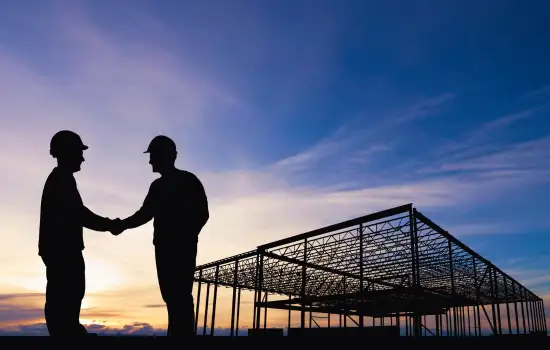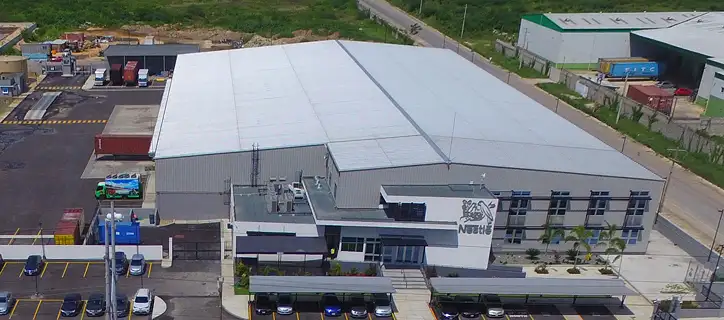What are the Advantages of PEMBs?
Pre-engineered metal buildings are prized for their cost-efficiency, time savings, reliability and durability, customization options, and sustainability. These structures are designed and fabricated offsite, reducing construction timelines and labor costs.
Read more about the advantages of pre-engineered metal buildings.
What Are the Advantages of PEMBs?
PEMBs are engineered for durability and performance in demanding environments, offering a long lifespan with minimal maintenance. Their customizable nature also allows for flexibility in design and layout, while their steel construction makes them environmentally friendly and recyclable. Pre-engineered metal buildings (PEMBs) deliver a range of benefits that make them an ideal choice for commercial and industrial construction projects:
- Cost Efficiency: PEMBs are engineered in a controlled factory setting, reducing waste and minimizing labor costs. Their streamlined design and simplified assembly reduce on-site expenses. >> Read More
- Time Savings: With pre-fabrication, construction time is significantly shortened. Components arrive ready to assemble, enabling faster project completion compared to traditional builds. >> Read More
- Reliability and Durability: Steel structures are resistant to pests, fire, and weather-related damage. PEMBs are engineered to meet local building codes and can be tailored to withstand seismic or wind loads. >> Read More
- Customizability: Design flexibility allows for custom layouts, interior clear spans, facades, insulation packages, and more. You can adapt your building to meet exact operational or aesthetic needs. >> Read More
- Sustainability: Steel is one of the most recycled materials in the world. Many PEMBs incorporate energy-efficient features like cool roof coatings and insulation systems that help reduce long-term energy use. >> Read More
These combined benefits make PEMBs a forward-thinking choice for builders seeking performance, flexibility, and long-term value.
What are Some Commercial Applications of PEMBs?
PEMBs serve a wide range of industries thanks to their adaptability and affordability. Common uses include warehouses, distribution centers, retail stores, office buildings, auto shops, churches, and even schools or sports complexes. Their quick installation and minimal maintenance make them especially attractive to businesses looking to scale quickly.
Read more about the commercial applications of pre-engineered metal buildings.
What are Some Commercial Applications of PEMBs?
PEMBs are an excellent solution for businesses in need of functional, scalable space. Common commercial applications include:
- Warehouses and Distribution Centers: Their wide, clearspan interior spaces are ideal for storage and logistics operations. >> Read More
- Retail Buildings: Fast construction timelines and design versatility make PEMBs a great fit for retail chains and independent stores. Large bays and overhead doors make PEMBs ideal for auto shops and showrooms. >> Read More
- Data Centers: Modern PEMBs can be configured with finished interiors and insulation to meet data center standards.>> Read More
- Community and Recreational Facilities: Many churches and community centers rely on PEMBs for cost-effective, spacious gathering places. Schools, gyms, and sports arenas also benefit from PEMB efficiency and durability. >>Read More
Because these buildings are so versatile, they continue to gain popularity across sectors that prioritize cost savings and speed.
What Industry Leaders Are Saying
Don’t just take our word for it. -Discover how Allied Steel has delivered unmatched quality, reliability and results as we bring their biggest projects to life.

What Types of Steel Buildings Can Be Pre-Engineered?
Virtually any steel structure can be pre-engineered, including manufacturing plants, aircraft hangars, agricultural buildings, and more. Industries like aviation, logistics, agriculture, retail, and recreation commonly rely on PEMBs for their scalability, affordability, and performance.
Read more about how PEMBs are an excellent choice for different types of structures.
What Types of Steel Buildings Can Be Pre-Engineered?
PEMBs can be tailored for a wide range of building types, including:
- Industrial Buildings: Manufacturing plants, data centers, assembly facilities, and fabrication shops.>> Read More
- Commercial Buildings: Retail, aviation hangars, warehouses, storage and office space >> Read More
- Agricultural Buildings: Barns, grain storage, equipment sheds, and livestock shelters. >> Read More
- Recreational Facilities: Indoor and equestrian arenas, gyms, and community centers. >> Read More
Each of these applications benefits from PEMBs’ ability to offer large clear spans, energy efficiency, and rapid build times.
What are the Components of a PEMB?
A PEMB consists of engineered structural components including framing systems, roofing, wall panels, and openings. Building orientation is critical for load distribution and energy efficiency. Key frame types include clear span, single slope, and multi-span designs, each suited to different applications. Engineered openings for windows, doors, and bays ensure functionality without compromising structural integrity.
Read more about the components of a PEMB.
What Are the Components of a PEMB?
The major components of a PEMB include:
- Framing System: Includes primary frames (rigid steel columns and rafters) and secondary members (purlins and girts). Frame options:
- Clear Span: Ideal for unobstructed interior space.
- Single Slope: Common for lean-tos or add-ons.
- Multi-Span: Used for very large structures requiring interior support.
- Roof and Wall Panels: Panels are often made of corrugated steel and can be insulated or coated depending on environmental needs. >> Read More
- Engineered Openings: Doors, windows, and bay openings are reinforced to maintain structural integrity while offering accessibility. >> Read More
- Orientation Considerations: Proper building orientation enhances wind resistance, daylighting, and energy efficiency. >> Read More
Together, these elements create a structure that’s strong, flexible, and suited for long-term use.
Engineered for Complexity - Built for Performance
WHEN STANDARD SOLUTIONS WON’T CUT IT ALLIED STEEL DELIVERS.
Learn how our hybrid designs combine the efficiency of pre-engineered steel with the flexibility of conventional methods to meet the demands of complex projects.

What Are Important Cost Considerations for PEMBs?
Several factors influence the cost of a PEMB. Design complexity, fluctuating steel prices, fuel and transportation costs, the manufacturer’s buying power, and additional custom features all contribute to the final price. Understanding these variables early in your project helps with budgeting and decision-making.
Read more about the components of a PEMB.
5 Important Cost Considerations for PEMBs
When budgeting for a PEMB, consider these key cost drivers:
- Building Design: More complex layouts or specialty uses will require additional engineering and fabrication time. >> Read More
- Steel Prices: Steel market fluctuations can impact costs significantly. Purchasing during a dip can yield major savings. >> Read More
- Fuel and Transportation: Delivery of steel components affects total project cost, especially for remote locations. >> Read More
- Buying Power: Large-volume suppliers can often negotiate lower prices from mills and pass those savings on to customers. >> Read More
- Custom Features: Architectural finishes, custom facades, or advanced insulation systems can add to the base price but may improve ROI. >> Read More
Being aware of these variables helps you build strategically and avoid unexpected budget overruns.
How Do You Select the Right Steel for Your PEMB?
Choosing the right steel for your PEMB involves evaluating grade standards, thickness, coatings, and fabrication methods. High-quality steel ensures structural performance and longevity. Builders should weigh cost against long-term value, ensuring the selected steel matches the project’s functional and environmental demands.
Read more about how to select the right steel for your PEMB.
How Do You Select the Right Steel for Your PEMB?
The steel you choose for your PEMB affects its strength, durability, and maintenance needs:
- Grades and Standards: ASTM and AISI standards help ensure uniform strength and performance. Select grades that align with your building codes and application. >> Read More
- Thickness and Weight: Thicker steel offers higher load capacity but increases cost. Match the thickness to your structural demands. >> Read More
- Coatings and Finishes: Galvanized and painted finishes protect against corrosion. Consider location-specific threats like salt or humidity. >> Read More
- Welding and Fabrication Quality: Poor welds or fabrication can compromise structural integrity. Use trusted manufacturers. >> Read More
- Cost vs. Worth: Cheaper steel may save money upfront but cost more in repairs or performance issues over time. >> Read More
Making the right steel selection sets the foundation for a durable, cost-effective PEMB that performs over decades.
